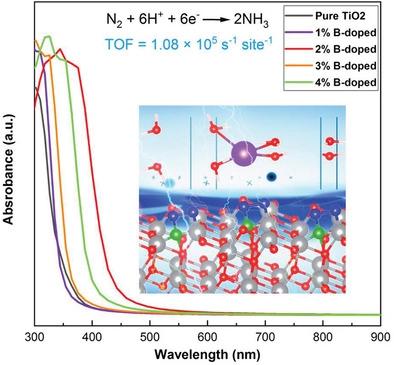当前位置:
X-MOL 学术
›
Adv. Energy Mater.
›
论文详情
Our official English website, www.x-mol.net, welcomes your
feedback! (Note: you will need to create a separate account there.)
Knowledge-Driven Design and Lab-Based Evaluation of B-doped TiO2 Photocatalysts for Ammonia Synthesis
Advanced Energy Materials ( IF 24.4 ) Pub Date : 2023-01-01 , DOI: 10.1002/aenm.202204126 Chuangwei Liu 1 , Derek Hao 2 , Jin Ye 3 , Sheng Ye 4 , Fengling Zhou 5 , Hongbo Xie 1 , Gaowu Qin 1 , Jiating Xu 3 , Jian Liu 4, 6 , Song Li 1 , Chenghua Sun 5, 7
Advanced Energy Materials ( IF 24.4 ) Pub Date : 2023-01-01 , DOI: 10.1002/aenm.202204126 Chuangwei Liu 1 , Derek Hao 2 , Jin Ye 3 , Sheng Ye 4 , Fengling Zhou 5 , Hongbo Xie 1 , Gaowu Qin 1 , Jiating Xu 3 , Jian Liu 4, 6 , Song Li 1 , Chenghua Sun 5, 7
Affiliation

|
The room-temperature nitrogen reduction reaction (NRR) is of paramount significance for both the fertilizer industry and fundamental catalysis science. To produce ammonia from water, air, and sunlight, the photocatalytic NRR is targeted to significantly release the energy and environmental pressure associated with the current Habor–Bosch process. In this context, herein, the knowledge-driven design of boron-doped TiO2 is demonstrated as a photocatalyst for the nitrogen reduction reaction. Among 54 catalysts in the reported library, anatase TiO2(101) modified by boron doping is identified as an exceptional NRR catalyst with strong visible-light absorption (bandgap 1.92 eV) and excellent reactivity with a small thermodynamic barrier (0.44 eV) as well as a high turnover frequency (1.08 × 10−5 s−1 site−1). Experimentally, the predictions of this work are validated using a B-doped TiO2 nanosheet, achieving ammonia production with a yield of 3.35 mg h−1 g−1 under simulated sunlight irradiation, which significantly renews the performance record for Ti-based photocatalyst for the NRR. This work highlights the importance of dual active site catalysts for nitrogen activation and reduction and demonstrates the capacity of knowledge-driven catalyst design.
中文翻译:

用于合成氨的 B 掺杂 TiO2 光催化剂的知识驱动设计和基于实验室的评估
室温氮还原反应 (NRR) 对于化肥工业和基础催化科学都具有至关重要的意义。为了从水、空气和阳光中生产氨,光催化 NRR 旨在显着释放与当前 Habor-Bosch 工艺相关的能量和环境压力。在此背景下,本文证明了硼掺杂 TiO 2的知识驱动设计作为氮还原反应的光催化剂。在报告库中的 54 种催化剂中,锐钛矿 TiO 2(101) 通过硼掺杂改性被确定为一种特殊的 NRR 催化剂,具有强可见光吸收(带隙 1.92 eV)和优异的反应性,具有小的热力学势垒(0.44 eV)以及高转换频率(1.08 × 10 -5 s -1位点-1 )。在实验上,这项工作的预测使用 B 掺杂的 TiO 2纳米片进行了验证,实现了产率为 3.35 mg h −1 g −1的氨生产在模拟太阳光照射下,这显着刷新了用于 NRR 的钛基光催化剂的性能记录。这项工作强调了双活性中心催化剂对氮活化和还原的重要性,并展示了知识驱动催化剂设计的能力。
更新日期:2023-01-01
中文翻译:

用于合成氨的 B 掺杂 TiO2 光催化剂的知识驱动设计和基于实验室的评估
室温氮还原反应 (NRR) 对于化肥工业和基础催化科学都具有至关重要的意义。为了从水、空气和阳光中生产氨,光催化 NRR 旨在显着释放与当前 Habor-Bosch 工艺相关的能量和环境压力。在此背景下,本文证明了硼掺杂 TiO 2的知识驱动设计作为氮还原反应的光催化剂。在报告库中的 54 种催化剂中,锐钛矿 TiO 2(101) 通过硼掺杂改性被确定为一种特殊的 NRR 催化剂,具有强可见光吸收(带隙 1.92 eV)和优异的反应性,具有小的热力学势垒(0.44 eV)以及高转换频率(1.08 × 10 -5 s -1位点-1 )。在实验上,这项工作的预测使用 B 掺杂的 TiO 2纳米片进行了验证,实现了产率为 3.35 mg h −1 g −1的氨生产在模拟太阳光照射下,这显着刷新了用于 NRR 的钛基光催化剂的性能记录。这项工作强调了双活性中心催化剂对氮活化和还原的重要性,并展示了知识驱动催化剂设计的能力。


















































 京公网安备 11010802027423号
京公网安备 11010802027423号